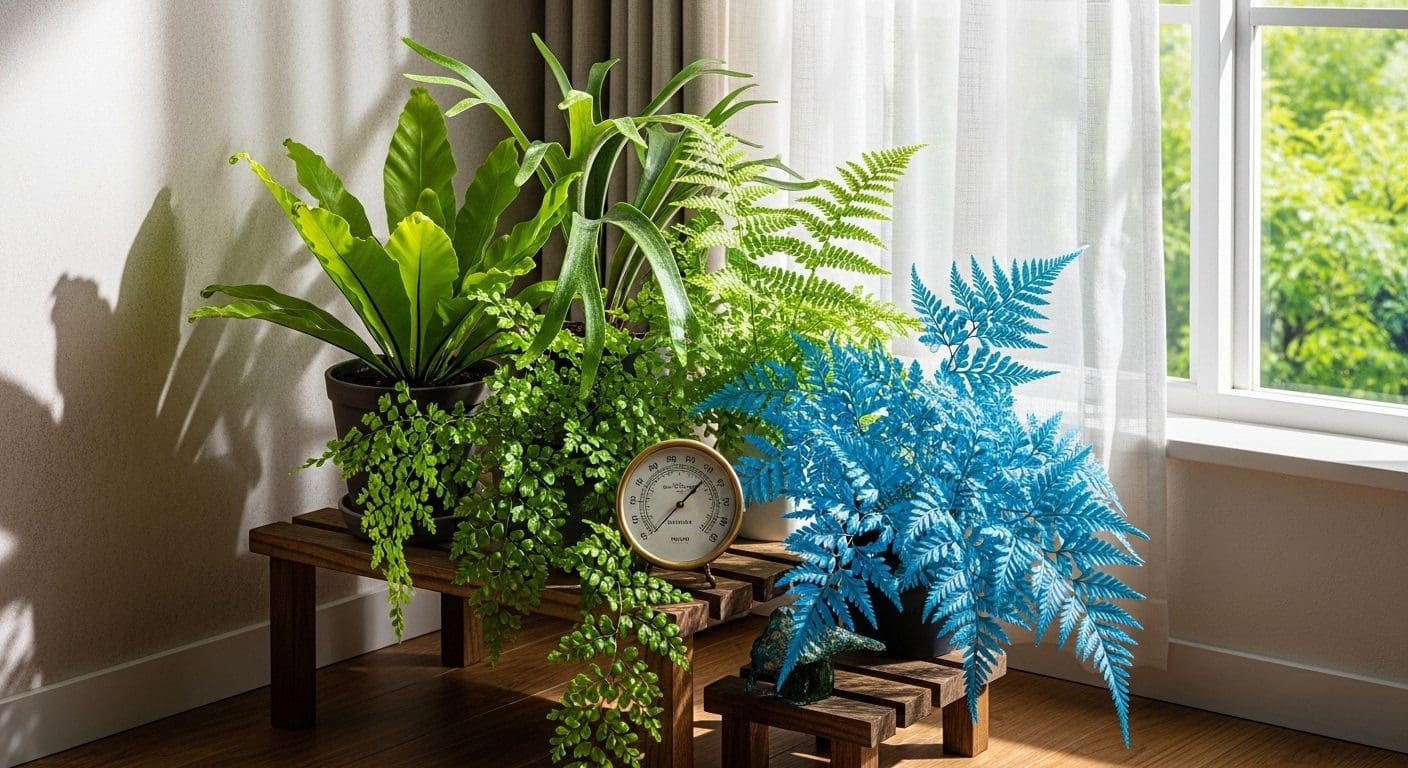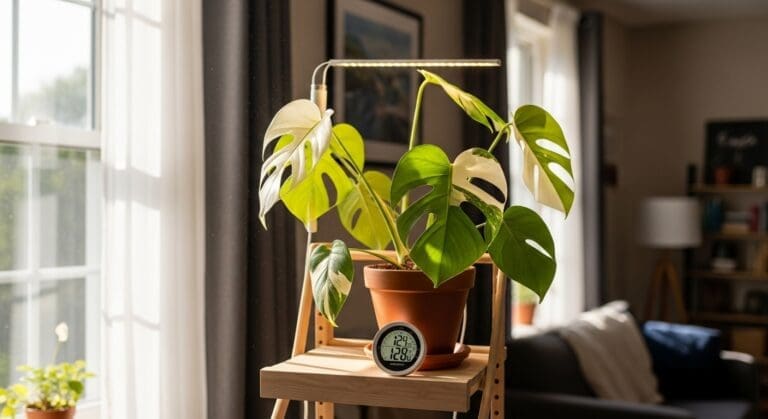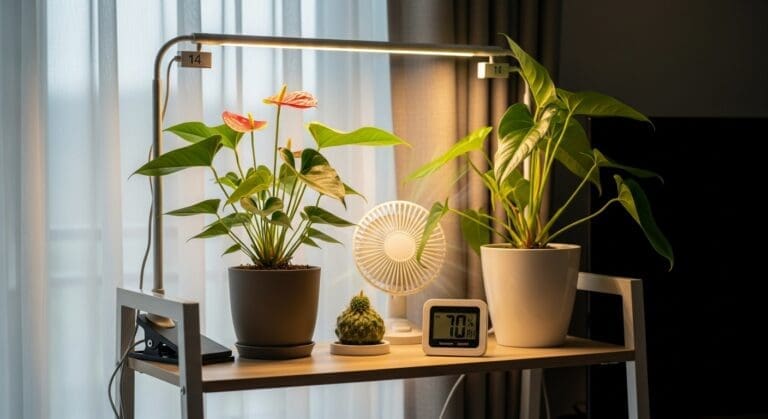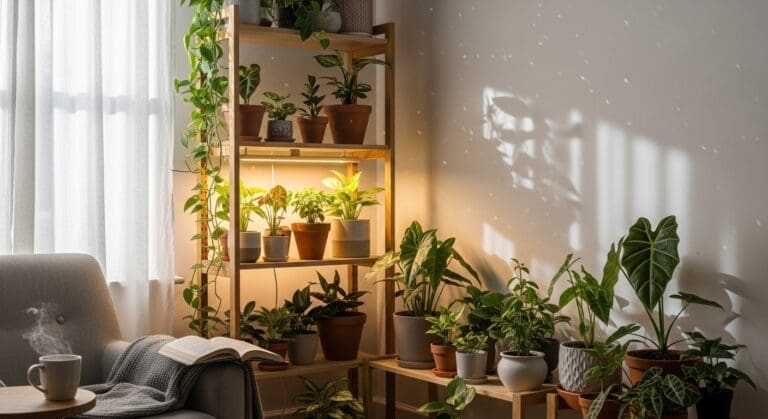If you love rare foliage but live in a small apartment, this is the one guide you can bookmark and return to whenever a frond looks off. “I still smile every time new fiddleheads unfurl—tiny green question marks promising a good week.”
This long-form pillar walks you through Rare Ferns Indoors care from light and watering to humidity, potting mix, propagation, and real-world fixes. It’s written for compact homes, radiator-heated rooms, and bright windows you’ll meter with your phone.
Table of Contents
- Quick‑Start Essentials
- Light for Rare Ferns Indoors
- Watering Fundamentals & The Calibration Method
- Humidity That Actually Works in Homes
- Potting Mix That Stays Evenly Moist (Peat‑Free Recipe)
- Feeding Without Burn
- Repotting & Aftercare
- Propagation Options
- Seasonal Adjustments
- Troubleshooting — Symptom → Cause → Fix
- Gear That Helps (Quiet, Compact, Reliable)
- Mini Species Snapshots (Link Out to Full Guides)
- Expert Insight
- FAQs
Quick‑Start Essentials
Summary: Rare ferns thrive on bright‑indirect light, evenly moist—but airy—soil, and steady humidity around 55–65% RH.
Place them where you can read comfortably at midday without squinting; that’s your bright‑indirect baseline. Keep the mix evenly moist: water when the top 1–2 cm just begins to feel dry. Aim for 55–65% humidity; if radiator heat dries the room, use a small humidifier. Choose a peat‑free mix that holds moisture yet breathes; plastic or glazed pots slow drying for beginners. Feed lightly at ¼–½ strength during active growth and skip deep winter. Repot in spring with only +2–3 cm pot size.
Is that east‑facing window enough, or should you add a sheer curtain to soften late sun?
Light for Rare Ferns Indoors
Summary: Bright‑indirect light means strong ambient brightness without hot rays landing on fronds.
Think filtered forest light. In practice, park your ferns 1–2 m from an east or northeast window, or right by a north window if the room stays bright. A west window works with a sheer curtain to soften afternoon glare. If your sill is narrow, a slim shelf just inside the frame spreads light nicely.
Use your phone as a quick meter: target 2,000–5,000 lux (≈200–500 foot‑candles) for most indoor ferns. Maidenhair enjoys the higher end if humidity is excellent; Blue Star is forgiving a touch lower. If leaves bleach or crisp, you’re getting hit by direct rays—step back or add sheer.
Rhetorical check‑in: do you really have to move furniture, or can a clip‑on shelf under the frame give your fern that perfect glow?
[Featured Image Prompt: A realistic city apartment windowsill with rare ferns (Maidenhair, Blue Star, Rabbit’s Foot) arranged near an east-facing window, soft morning light, a sheer curtain diffusing sun, subtle urban skyline outside, cozy lived-in vibe, no text overlays] ALT TEXT: Rare ferns on an east-facing windowsill with sheer curtain and soft morning light
Internal reads you’ll want later: Maidenhair Fern Care, Blue Star Fern Care, and a practical setup guide: Grow‑Light Setup for Ferns.
Watering Fundamentals & The Calibration Method
Summary: Water on a repeatable rhythm you calibrate to your home; consistency beats intensity.
Ferns want even moisture with air around roots. Calibrate with three tiny habits: tap the surface (water when the top 1–2 cm moves from damp to barely dry), “weigh” the pot by hand (you’ll learn its sweet‑spot heft), and use a wooden skewer as a probe (if it comes out almost clean, it’s time). Always water slowly until a little drains; discard saucer water. If the mix shrinks from pot edges, bottom‑water for 20–30 minutes, then resume normal top watering next time.
Month‑by‑Month Watering Schedule (adjust to your light, pot, and humidity)
| Month | Bright‑indirect; 12–15 cm plasticpot; RH 55–65% | Same light; terracotta pot; RH 45–55% | Lower light room; 12–15 cm plastic; RH 55–65% |
|---|---|---|---|
| Jan | Every 5–7 days | Every 3–5 days | Every 7–9 days |
| Feb | Every 4–6 days | Every 3–4 days | Every 6–8 days |
| Mar | Every 3–5 days | Every 2–4 days | Every 4–6 days |
| Apr | Every 3–4 days | Every 2–3 days | Every 4–5 days |
| May | Every 2–4 days | Every 2–3 days | Every 3–5 days |
| Jun | Every 2–4 days | Every 2–3 days | Every 3–5 days |
| Jul | Every 2–4 days | Every 2–3 days | Every 3–5 days |
| Aug | Every 2–4 days | Every 2–3 days | Every 3–5 days |
| Sep | Every 3–4 days | Every 2–3 days | Every 4–6 days |
| Oct | Every 3–5 days | Every 2–4 days | Every 5–7 days |
| Nov | Every 4–6 days | Every 3–5 days | Every 6–8 days |
| Dec | Every 5–7 days | Every 3–5 days | Every 7–9 days |
These are realistic ranges, not commandments. Pot size, soil recipe, airflow, and light all nudge frequency. If tips crisp even though you’re watering well, look at humidity and salts, not just the calendar.
Humidity That Actually Works in Homes
Summary: Aim for 55–65% RH with gentle airflow; misting alone won’t carry you.
Most living rooms sit at 35–45% RH in heating season, which is why frond tips crisp. Grouping plants raises the local microclimate a touch. Pebble trays help only a little; they matter more for airflow than for massive humidity jumps. A quiet humidifier with a built‑in hygrometer is the reliable route—set a target and let it cruise.
If you’re worried about noise at night, park the humidifier 2–3 meters away and run it on low. Keep some airflow so leaves don’t sit wet and cool, which invites fungus. “I used to mist daily and wonder why nothing changed—until the hygrometer taught me what ‘60%’ truly feels like.”
[Featured Image Prompt: A believable living room corner with a cluster of rare ferns on a wooden stand, a small ultrasonic humidifier emitting a gentle mist, warm lamp light, radiator under a window with a sheer curtain, cozy apartment style, no text] ALT TEXT: Living room fern cluster with small humidifier and sheer-curtained window
Cross‑reads: Humidity Guide for Indoor Ferns and pest prevention: Fungus Gnats Control for Houseplants.
Potting Mix That Stays Evenly Moist (Peat‑Free Recipe)
Summary: Use a moisture‑holding yet airy recipe and tweak it to your home’s drying speed.
Fern roots are built for “air + moisture.” A dependable peat‑free base is 40% fine bark, 30% coco coir, 20% perlite or pumice, and 10% worm castings. If your home runs warm and dry, add 5–10% more coco; if cool and damp, add 5–10% more bark/perlite. The goal is a mix that clumps softly when moist, then breaks easily with a nudge.
If your soil goes hydrophobic (water beads and runs off), set the pot in a tray of water for 20–30 minutes, then resume slow top watering; next repot, add a bit more coco/compost. For mounted Staghorn, think moss and fine bark rather than potting mix; keep the pad airy so the basal plate doesn’t rot.
[Featured Image Prompt: A warm kitchen table scene with a person repotting a rare fern into a peat-free mix (fine bark, coco coir, perlite), small scoop, newspaper under the pot, afternoon light, realistic textures, no text] ALT TEXT: Repotting a rare fern into a peat-free mix on a kitchen table
More depth: Best Peat‑Free Potting Mix for Ferns and Staghorn Mount Care.
Feeding Without Burn
Summary: Light, regular feeding beats heavy doses—¼–½ strength in active growth, then flush salts.
Ferns are light feeders. Give a balanced liquid feed at low strength every 4–6 weeks when actively growing, and skip deepest winter. Watch for salt crust on the surface or crisp margins—classic overfeeding signs. Every 6–8 weeks, water generously with plain water to wash out built‑up salts. If your tap water is hard, consider filtered or collected rainwater.
If you prefer organic routes, dilute seaweed/fish emulsion or worm‑cast tea to ¼ strength; they’re gentler but can smell, so ventilate after feeding. Slow‑release granules in tiny indoor pots often overdo salts—use sparingly or avoid. When in doubt, feed less but more consistently and let leaf color and frond size guide adjustments.
Water quality is part of nutrition: high bicarbonates can raise media pH and lock out iron, which shows as interveinal chlorosis (pale leaf with green veins). Switching to filtered/rainwater and a mild, chelated iron supplement can restore color without pushing nitrogen.
Repotting & Aftercare
Summary: Repot in spring, step up only one size, and pamper with higher humidity for a week.
Choose a pot just 2–3 cm wider than the old one to avoid long‑wet soil zones. Ease the root ball out, trim any mushy roots, and set into fresh mix without compacting. Water slowly, let excess drain, then keep the plant in bright‑indirect light with slightly higher humidity for 5–7 days. For mounted species like Staghorn, refresh the moss pad and bindings, then support with extra humidity while it re‑anchors.
A good repot feels like a reset: breathe new air into the root zone, then keep moisture even (not soggy) while new feeder roots colonize. Hold fertilizer for 3–4 weeks so tender roots aren’t burned. If the plant sulks (common after major root work), reduce light intensity slightly for a week and raise RH to ~60%.
Signs you repotted well: new fronds unfurl within 3–6 weeks, irrigation frequency becomes more predictable, and no sour smell develops from the mix. If you do smell sourness, pull back on watering, increase airflow, and check drainage holes for blockages.
Propagation Options
Summary: Division and rhizome sections are beginner‑friendly; spores are advanced but rewarding.
Division works well on Boston‑type and Rabbit’s Foot ferns: split the root mass into sections with multiple growth points and pot each in small containers. Rhizome sections (a rhizome is a horizontal stem that creeps along the surface) are easy with Davallia—press lightly into mix and keep evenly moist. Spore growing is a slow, sterile‑tech adventure: sow onto clean, moist medium, cover, and wait weeks for heart‑shaped prothalli (juvenile fern stage) before tiny fronds appear.
Simple hygiene boosts success. Sterilize blades with alcohol, dust cut surfaces with cinnamon or sulfur (optional), and use fresh, moistened mix. Keep newly divided plants in higher humidity (≈60–70%) with gentle airflow; a clear propagator lid works if you vent daily to prevent mold. Expect 4–8 weeks for divisions to root in and resume normal growth.
Mounted Staghorn pups detach best when they’ve formed at least one‑third of their own root pad. When remounting, compress sphagnum just enough to hold moisture while still breathing; then fix firmly so the plant doesn’t wobble as roots knit.
Seasonal Adjustments
Summary: In short days, pull back on water and boost light; in heat, shorten intervals and soften glare.
Winter brings low angles and dry air. Move ferns closer to windows (without leaf‑to‑glass contact), reduce watering frequency slightly, and watch humidity. In summer, add a sheer to west windows to prevent scorch and check moisture more often. For travel, set up a capillary mat or a trusted drip system so you can leave for 1–2 weeks without panic. “I’ve learned to label pots with last‑watered dates—future‑me always thanks present‑me.”
Troubleshooting — Symptom → Cause → Fix
Summary: Diagnose fast using visible signs, confirm with a quick check, then act.
| Symptom | Likely Cause | Quick Check | Fix |
| Crispy brown tips | Low humidity, excess salts, too much sun | RH under 50%? Salt crust on soil? | Raise RH to 55–65%; flush with plain water; add sheer curtain |
| Overall yellowing | Overwatering, low light, nutrient lack | Soil sour smell? Heavy pot? Dim room? | Open drainage; brighten placement; feed ¼–½ strength |
| Sudden droop | Root rot or heat stress | Inspect roots; feel leaf temperature | Trim rot; repot into airy mix; move out of hot rays |
| Pale patches | Sun scorch or hard water spotting | Direct rays at midday? | Step back, add sheer; try filtered or rainwater |
| Fungus gnats | Constantly wet surface; organic-rich mix | See tiny flies at soil surface? | Let top 1 cm dry; bottom‑water; sticky traps; Fungus Gnats Control |
For deep dives, see Root Rot in Ferns — Save Your Plant and water quality notes: Safer Watering for Delicate Ferns.
Gear That Helps (Quiet, Compact, Reliable)
Summary: Choose compact tools that raise success without adding noise or clutter.
- Hygrometer to watch RH; small ultrasonic humidifier for steady moisture; LED grow light on a timer for dim rooms; self‑watering pots only if you keep the top layer drier to deter gnats; a fine‑spray bottle for moss pads on mounts.
To keep visuals low‑key in small spaces, tuck the humidifier behind a plant stand and run a cord channel up the wall for the light timer. Place the hygrometer sensor near leaf height rather than on a cold windowsill; readings there can mislead you on real leaf‑zone humidity. For different outlet standards, use quality adapters rated for continuous use and avoid overloading splitters.
[Featured Image Prompt: A minimalist apartment corner showing a tidy setup—compact humidifier behind a wooden plant stand, a discrete LED grow light with timer, cord management along the wall, hygrometer sensor clipped near fern foliage, warm evening light, realistic, no text] ALT TEXT: Minimal fern gear setup with humidifier, LED on timer, and hygrometer near foliage
Mini Species Snapshots (Link Out to Full Guides)
Summary: Start with forgiving species, then graduate to the divas.
Blue Star Fern (Phlebodium aureum): Forgiving, loves bright‑indirect and evenly moist mix; leaves go dull when light is low. Read more: Blue Star Fern Care.
Rabbit’s Foot Fern (Davallia fejeensis): Rhizomes creep adorably over the rim; keep mix moist but airy. Deep dive: Rabbit’s Foot Fern Watering Schedule.
Staghorn Fern (Platycerium bifurcatum): Spectacular on a mount; soak and drain thoroughly, then let the pad breathe. Details: Staghorn Mount Care.
Maidenhair Fern (Adiantum spp.): Demanding diva; needs stable humidity and gentle light. Help is here: Maidenhair Fern Care.
Expert Insight
Summary: Trust time‑tested principles from horticultural experts.
“Most fern species are woodland plants and thrive in moist, humus‑rich conditions with shelter from direct sun,” notes the Royal Horticultural Society in its houseplant guidance. You can explore their practical overview here: Royal Horticultural Society — Ferns as Houseplants. The big idea aligns with our home reality: bright, indirect light; never bone‑dry compost; steady humidity.
FAQs
Summary: Quick answers to calm the classic anxieties.
How do I know if my room is bright enough? If you can read comfortably at noon without squinting and your phone shows ~2,000–5,000 lux near the plant, you’re in range.
Should I mist every day? Misting is fleeting. It can feel good but won’t hold 55–65% RH; a small humidifier + light airflow is more reliable.
Can I use self‑watering pots? Yes, if you keep the top centimeter on the drier side and refresh water regularly to prevent stagnation and gnats.
Why are tips browning even with good watering? Check humidity and salts. Raise RH, flush the mix, and consider filtered or rainwater if your tap is hard.
Do ferns need fertilizer? A little, rarely. ¼–½ strength every 4–6 weeks in active growth is plenty. Skip mid‑winter unless under strong grow lights.

RarePlantCare Editorial Team produces expert content on rare plants.
Our articles are AI-assisted and human-edited before publication.
We aim to provide practical, evidence-based guides for plant lovers worldwide.
Learn more about our Editorial Policy





